Research on Intelligent Control Technology for a Rail-Based High-Throughput Crop Phenotypic Platform Based on Digital Twins
Abstract
1. Introduction
2. Materials and Methods
2.1. System Architecture Design
2.2. Key Technical Methods
2.2.1. Digital Twin Data Synchronization
2.2.2. Digital Twin Condition Monitoring
2.2.3. Meteorological Sensing-Driven Strategy for Dynamic Collection of Phenotypic Data
- (1)
- Risk indicator framework.
- 0~2 m/s: stems and leaves only slight vibrations;
- 2~3 m/s: first visible leaf bending;
- 3~4 m/s: larger leaf oscillation and point cloud noise visible to the naked eye;
- >4 m/s: severe tilting and frequent frame loss.
- (2)
- Analytic hierarchy process (AHP) and fuzzy comprehensive evaluation methods
- (3)
- Fuzzy Integrated Evaluation
- (4)
- Risk evaluation rules
3. Results
3.1. System Performance
- (1)
- Heterogeneous data real-time synchronization performance
- (2)
- Automated operational exception-handling ability
3.2. Meteorological Adaptive-Driven Optimization of Phenotype Acquisition
- Extreme weather warnings: No extreme weather warnings occurred during the monitoring period of the weather risk assessment module of the digital twin system.
- High-Risk Task Avoidance: On 23 June, the system monitored sustained level 3 wind (wind speed 4.0–4.8 m/s) and light fluctuations (PAR 600–1100 μmol/m2/s) and decided that the periods of 13:30 and 16:30 on that day were high-risk, so it took the initiative to cancel the two collection tasks to avoid invalid data collection due to the strong wind.
- Dynamic Task Suspension–Resumption: On 24 June and 12 July, the system triggered a single high-risk warning for episodic gusts of wind (4.0 m/s) and heavy rainfall (7.5 mm/h), which was determined by suspending the collection for 5 min and then automatically resumed after the risk scores were normalized to reduce the amount of invalid data.
- Non-Operational Hours Warning: On 21 and 29 June, the system detected light rain (1.2 mm/h) and heavy rain (rainfall >14.9 mm/h after 18:00) during non-operational hours, generating a warning log for manual review without affecting the normal operational process.
- General Risk Alerts: A total of 296 general risk determinations were also triggered during the 27th experiment, with several frequent warnings occurring for high winds, rainfall, and other weather. The system issued alerts to assist the staff in operational decision-making.
4. Discussion
5. Conclusions
Author Contributions
Funding
Institutional Review Board Statement
Data Availability Statement
Acknowledgments
Conflicts of Interest
Appendix A
| Real-Time Weather | Weather Forecast | Risk Score B | |||||
|---|---|---|---|---|---|---|---|
| Measurement Time | Wind m/s | PAR μmol/m2/s | Precip mm/5 min | Wind Power | Weather Level * | Weather | |
| 6/21/24 12:50 | 3.08 | 276.5 | 0.2 | 1 | 3 | Light rain | 62.6 |
| 6/23/24 12:45 | 4.03 | 840.5 | 0.0 | 3 | 2 | Cloudy~Sunny | 60.2 |
| 6/23/24 12:50 | 4.06 | 446.8 | 0.0 | 3 | 2 | Cloudy~Sunny | 57.4 |
| 6/23/24 13:40 | 4.33 | 1409.9 | 0.0 | 3 | 2 | Cloudy~Sunny | 63 |
| 6/23/24 13:50 | 4.24 | 351.6 | 0.0 | 3 | 2 | Cloudy~Sunny | 57.4 |
| 6/23/24 14:00 | 4.17 | 265.5 | 0.0 | 3 | 2 | Cloudy~Sunny | 57.4 |
| 6/23/24 14:15 | 4.12 | 1221.3 | 0.0 | 3 | 2 | Cloudy~Sunny | 63 |
| 6/23/24 14:25 | 5.19 | 1278.1 | 0.0 | 3 | 2 | Cloudy~Sunny | 63 |
| 6/23/24 14:30 | 4.49 | 1272.6 | 0.0 | 3 | 2 | Cloudy~Sunny | 63 |
| 6/23/24 14:35 | 4.72 | 1292.7 | 0.0 | 3 | 2 | Cloudy~Sunny | 63 |
| 6/23/24 14:45 | 4.38 | 1089.5 | 0.0 | 3 | 2 | Cloudy~Sunny | 63 |
| 6/23/24 15:05 | 4.33 | 1085.8 | 0.0 | 3 | 2 | Cloudy~Sunny | 63 |
| 6/23/24 15:10 | 4.04 | 1054.7 | 0.0 | 3 | 2 | Cloudy~Sunny | 63 |
| 6/23/24 15:15 | 4.34 | 1029.1 | 0.0 | 3 | 2 | Cloudy~Sunny | 63 |
| 6/23/24 15:20 | 4.37 | 1030.9 | 0.0 | 3 | 2 | Cloudy~Sunny | 63 |
| 6/23/24 15:30 | 4.03 | 979.6 | 0.0 | 3 | 2 | Cloudy~Sunny | 60.2 |
| 6/23/24 16:05 | 4.51 | 596.9 | 0.0 | 3 | 2 | Cloudy~Sunny | 57.4 |
| 6/23/24 16:10 | 4.54 | 708.6 | 0.0 | 3 | 2 | Cloudy~Sunny | 60.2 |
| 6/23/24 16:35 | 4.26 | 655.5 | 0.0 | 3 | 2 | Cloudy~Sunny | 60.2 |
| 6/23/24 16:40 | 4.28 | 325.9 | 0.0 | 3 | 2 | Cloudy~Sunny | 57.4 |
| 6/23/24 16:45 | 4.66 | 699.5 | 0.0 | 3 | 2 | Cloudy~Sunny | 60.2 |
| 6/23/24 16:55 | 4.18 | 703.1 | 0.0 | 3 | 2 | Cloudy~Sunny | 60.2 |
| 6/23/24 17:00 | 4.19 | 712.3 | 0.0 | 3 | 2 | Cloudy~Sunny | 60.2 |
| 6/23/24 17:15 | 4.06 | 477.9 | 0.0 | 3 | 2 | Cloudy~Sunny | 57.4 |
| 6/23/24 17:40 | 3.78 | 181.3 | 0.0 | 3 | 2 | Cloudy~Sunny | 61.6 |
| 6/23/24 17:45 | 3.69 | 197.8 | 0.0 | 3 | 2 | Cloudy~Sunny | 61.6 |
| 6/23/24 17:50 | 4.10 | 146.5 | 0.0 | 3 | 2 | Cloudy~Sunny | 54.6 |
| 6/23/24 17:55 | 3.78 | 144.7 | 0.0 | 3 | 2 | Cloudy~Sunny | 61.6 |
| 6/23/24 18:10 | 4.05 | 250.9 | 0.0 | 3 | 2 | Cloudy~Sunny | 57.4 |
| 6/23/24 18:25 | 3.47 | 184.9 | 0.0 | 3 | 2 | Cloudy~Sunny | 61.6 |
| 6/23/24 18:30 | 3.05 | 157.5 | 0.0 | 3 | 2 | Cloudy~Sunny | 61.6 |
| 6/23/24 18:35 | 3.37 | 104.4 | 0.0 | 3 | 2 | Cloudy~Sunny | 61.6 |
| 6/23/24 18:40 | 3.23 | 128.2 | 0.0 | 3 | 2 | Cloudy~Sunny | 61.6 |
| 6/23/24 18:45 | 3.14 | 95.2 | 0.0 | 3 | 2 | Cloudy~Sunny | 61.6 |
| 6/23/24 18:50 | 3.30 | 93.4 | 0.0 | 3 | 2 | Cloudy~Sunny | 61.6 |
| 6/23/24 18:55 | 3.37 | 71.4 | 0.0 | 3 | 2 | Cloudy~Sunny | 61.6 |
| 6/24/24 13:55 | 4.02 | 195.9 | 0.0 | 2 | 1 | Sunny | 60.6 |
| 6/29/24 18:05 | 3.35 | 0.0 | 0.6 | 2 | 4 | Heavy rain~Light rain | 53.8 |
| 6/29/24 18:10 | 3.71 | 0.0 | 0.6 | 2 | 4 | Heavy rain~Light rain | 53.8 |
| 6/29/24 18:15 | 3.40 | 0.0 | 0.8 | 2 | 4 | Heavy rain~Light rain | 53.8 |
| 6/29/24 18:20 | 3.43 | 0.0 | 0.4 | 2 | 4 | Heavy rain~Light rain | 58 |
| 6/29/24 18:25 | 3.00 | 0.0 | 2.0 | 2 | 4 | Heavy rain~Light rain | 56.6 |
| 6/29/24 18:30 | 2.16 | 0.0 | 1.6 | 2 | 4 | Heavy rain~Light rain | 56.6 |
| 6/29/24 18:35 | 2.29 | 0.0 | 0.6 | 2 | 4 | Heavy rain~Light rain | 60.8 |
| 6/29/24 18:40 | 2.18 | 0.0 | 0.6 | 2 | 4 | Heavy rain~Light rain | 60.8 |
| 7/12/24 13:40 | 2.41 | 0.0 | 3.8 | 2 | 4 | Heavy rain~Light rain | 56.6 |
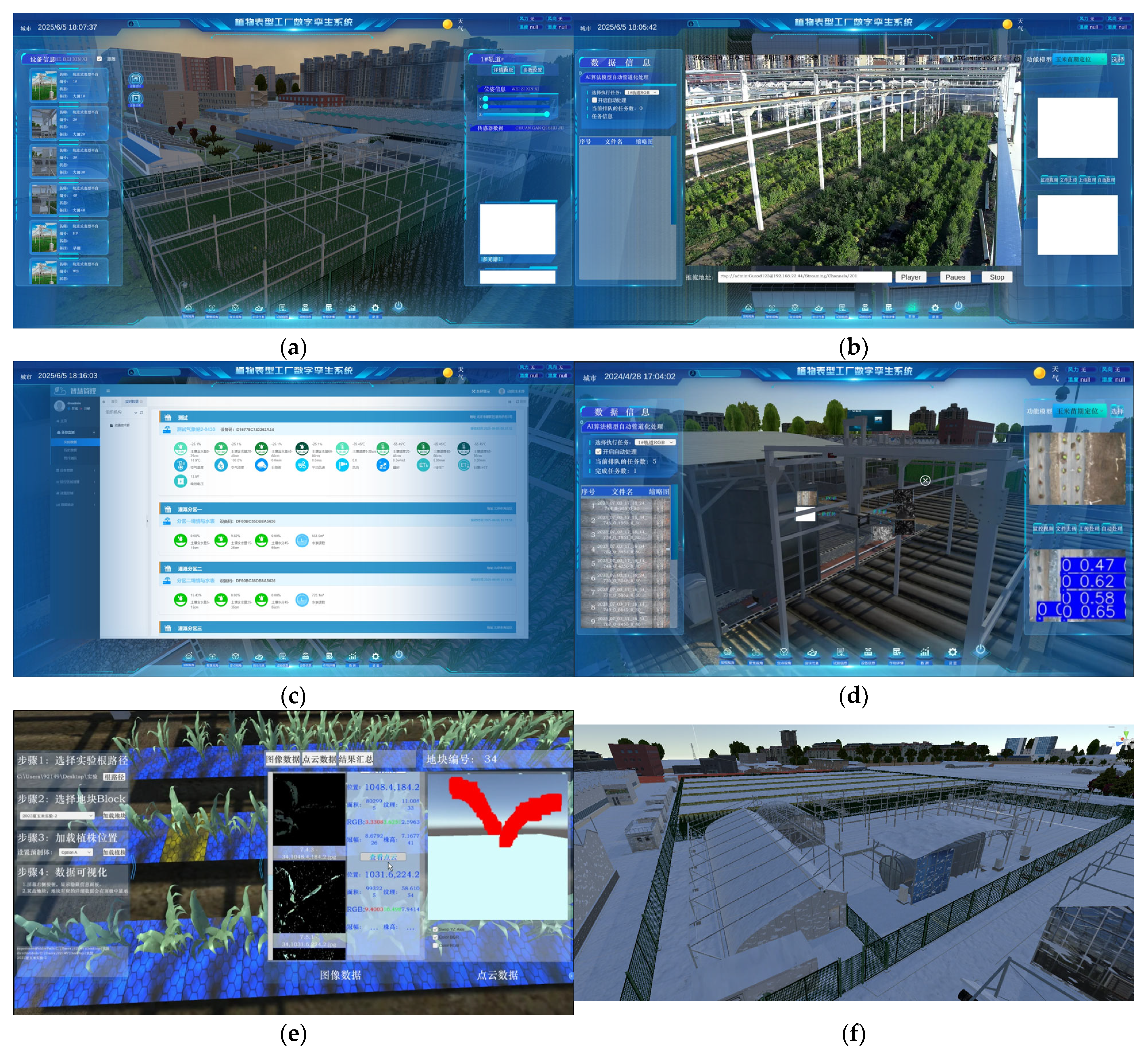
References
- Zhang, J.; Yao, Q.; Zhou, G.; Wu, W.; Xiu, X.; Wang, J. Intelligent Identification of Crop Agronomic Traits and Morphological Structure Phenotypes: A Review. Smart Agric. 2024, 6, 14–27. [Google Scholar] [CrossRef]
- Song, P.; Wang, J.; Guo, X.; Yang, W.; Zhao, C. High-Throughput Phenotyping: Breaking through the Bottleneck in Future Crop Breeding. Crop J. 2021, 9, 633–645. [Google Scholar] [CrossRef]
- Rui, Z.; Zhang, Z.; Zhang, M.; Azizi, A.; Igathinathane, C.; Cen, H.; Vougioukas, S.; Li, H.; Zhang, J.; Jiang, Y. High-Throughput Proximal Ground Crop Phenotyping Systems—A Comprehensive Review. Comput. Electron. Agric. 2024, 224, 109108. [Google Scholar] [CrossRef]
- Wen, W.; Gu, S.; Zhang, Y.; Yang, W.; Guo, X. Standard Framework Construction of Technology and Equipment for Big Data in Crop Phenomics. Engineering 2024, 42, 175–184. [Google Scholar] [CrossRef]
- Fan, J.; Li, Y.; Yu, S.; Gou, W.; Guo, X.; Zhao, C. Application of Internet of Things to Agriculture—The LQ-FieldPheno Platform: A High-Throughput Platform for Obtaining Crop Phenotypes in Field. Research 2023, 6, 0059. [Google Scholar] [CrossRef]
- Fan, J.; Zhang, Y.; Wen, W.; Gu, S.; Guo, X. The Future of Internet of Things in Agriculture: Plant High-Throughput Phenotypic Platform. J. Clean. Prod. 2020, 280, 123651. [Google Scholar] [CrossRef]
- Li, Y.; Wen, W.; Fan, J.; Gou, W.; Gu, S.; Lu, X.; Yu, Z.; Wang, X.; Guo, X. Multi-Source Data Fusion Improves Time-Series Phenotype Accuracy in Maize under a Field High-Throughput Phenotyping Platform. Plant Phenomics 2023, 5, 0043. [Google Scholar] [CrossRef]
- Tao, F.; Zhang, M. Digital Twin Shop-Floor: A New Shop-Floor Paradigm towards Smart Manufacturing. IEEE Access 2017, 5, 20418–20427. [Google Scholar] [CrossRef]
- Tao, F.; Cheng, J.; Qi, Q.; Zhang, M.; Zhang, H.; Sui, F. Digital Twin-Driven Product Design, Manufacturing and Service with Big Data. Int. J. Adv. Manuf. Technol. 2018, 94, 3563–3576. [Google Scholar] [CrossRef]
- Park, S.; Maliphol, S.; Woo, J.; Fan, L. Digital Twins in Industry 4.0. Electronics 2024, 13, 2258. [Google Scholar] [CrossRef]
- Li, H.; Yang, Y.; Zhang, C.; Zhang, C.; Chen, W. Visualization Monitoring of Industrial Detonator Automatic Assembly Line Based on Digital Twin. Sustainability 2023, 15, 7690. [Google Scholar] [CrossRef]
- Rauch, M.; Hascoet, J.-Y. Opening New Opportunities for Aeronautic, Naval and Train Large Components Realization with Hybrid and Twin Manufacturing. J. Mach. Eng. 2022, 22, 5–20. [Google Scholar] [CrossRef]
- Susarev, S.V.; Orlov, S.P.; Morev, A.S.; Kravets, O.J. Digital Tests of the Robotic Chassis’ Cyber-Physical System for Agricultural Unmanned Vehicle. J. Phys. Conf. Ser. 2019, 1399, 044032. [Google Scholar] [CrossRef]
- Guo, D.; Wang, L.; Du, Y.; Wu, Z.; Zhang, W.; Zhi, Q.; Ma, R. Online Optimization of Adjustable Settings for Agricultural Machinery Assisted by Digital Twin. Comput. Electron. Agric. 2024, 227, 109504. [Google Scholar] [CrossRef]
- Slob, N.; Hurst, W. Digital Twins and Industry 4.0 Technologies for Agricultural Greenhouses. Smart Cities 2022, 5, 1179–1192. [Google Scholar] [CrossRef]
- Melesse, T.Y. Digital Twin-Based Applications in Crop Monitoring. Heliyon 2025, 11, e42137. [Google Scholar] [CrossRef]
- Skobelev, P.O.; Mayorov, I.V.; Simonova, E.V.; Goryanin, O.I.; Yalovenko, V.V. Development of Models and Methods for Creating a Digital Twin of Plant within the Cyber-Physical System for Precision Farming Management. J. Phys. Conf. Ser. 2020, 1703, 012022. [Google Scholar] [CrossRef]
- Ibrahimov, F.; Rzayeva, U.; Balayev, R. Opportunities and Perspectives of the Digital Twins’ Conception: The Case in Agriculture. East. -Eur. J. Enterp. Technol. 2023, 1, 102–112. [Google Scholar] [CrossRef]
- Escriba-Gelonch, M.; Liang, S.; Van Schalkwyk, P.; Fisk, I.; Long, N.V.D.; Hessel, V. Digital Twins in Agriculture: Orchestration and Applications. J. Agric. Food Chem. 2024, 72, 10737–10752. [Google Scholar] [CrossRef]
- Liu, T.; Bao, J.; Zheng, Y.; Lu, Y. Digital Twin and Industrial Intelligence. Springer Cham 2025, 383–453. [Google Scholar] [CrossRef]
- Ibrahim, M.; Rjabtikov, V.; Rasslkin, A. Digital Shadow of an Electric Vehicle-Permanent Magnet Synchronous Motor Drive for Real-Time Performance Monitoring. Digit. Twins Appl. 2025, 2, e12024. [Google Scholar] [CrossRef]
- Iuchi, Y.; Kitamura, T.; Honjo, S.; Doi, T.; Imaoka, K.; Emaru, T. Method for Improving Speed of Instance Segmentation by Limiting Image Area Using High Precision Maps in Agricultural Field. Proc. JSME Annu. Conf. Robot. Mechatron. (Robomec) 2022, 2022, 1A1-M01. [Google Scholar] [CrossRef]
- Guo, X.; Qiu, Y.; Nettleton, D.; Schnable, P.S. High-Throughput Field Plant Phenotyping: A Self-Supervised Sequential CNN Method to Segment Overlapping Plants. Plant Phenomics 2023, 5, 0052. [Google Scholar] [CrossRef] [PubMed]
- Gao, Y.; Li, Y.; Jiang, R.; Zhan, X.; Lu, H.; Guo, W.; Yang, W.; Ding, Y.; Liu, S. Enhancing Green Fraction Estimation in Rice and Wheat Crops: A Self-Supervised Deep Learning Semantic Segmentation Approach. Plant Phenomics 2023, 5, 0064. [Google Scholar] [CrossRef]
- Wu, Y.; Wen, W.; Gu, S.; Huang, G.; Wang, C.; Lu, X.; Xiao, P.; Guo, X.; Huang, L. Three-Dimensional Modeling of Maize Canopies Based on Computational Intelligence. Plant Phenomics 2024, 6, 0160. [Google Scholar] [CrossRef]
- Moghadam, P.; Lowe, T. Digital Twin for the Future of Orchard Production Systems. Proceedings 2019, 36, 92. [Google Scholar] [CrossRef]
- Catala-Roman, P.; Navarro, E.A.; Segura-Garcia, J.; Garcia-Pineda, M. Harnessing Digital Twins for Agriculture 5.0: A Comparative Analysis of 3D Point Cloud Tools. Appl. Sci. 2024, 14, 1709. [Google Scholar] [CrossRef]
- Costa, G.; Forestiero, A.; Gentile, A.F.; Macrì, D.; Ortale, R.; Bernardi, B.; Cerruto, E. An AI-Driven Architecture for Precision Agriculture: IoT, Machine Learning, and Digital Twin Integration for Sustainable Crop Protection. In Proceedings of the 2024 IEEE International Conference on Big Data (BigData), Washington, DC, USA, 15–18 December 2024; pp. 4685–4691. [Google Scholar]
- Zarembo, I.; Kodors, S.; Apeināns, I.; Lācis, G.; Feldmane, D.; Rubauskis, E. Digital twin: Orchard management using uav. ETR 2023, 1, 247–251. [Google Scholar] [CrossRef]
- Madjid, M.K.A.; Noureddine, S.; Amina, B.; Khelifa, B.; Sofiane, A.; Ahmed, C. Design a Digital Twin Sensors System Using cGAN-LSTM for Greenhouse Climate Control. In Proceedings of the 2024 4th International Conference on Embedded & Distributed Systems (EDiS), Bechar, Algeria, 3–5 November 2024; pp. 132–136. [Google Scholar]
- Goldenits, G.; Mallinger, K.; Raubitzek, S.; Neubauer, T. Current Applications and Potential Future Directions of Reinforcement Learning-Based Digital Twins in Agriculture. Smart Agric. Technol. 2024, 8, 100512. [Google Scholar] [CrossRef]
- Zhang, J.; Wang, X.; Ni, X.; Dong, F.; Tang, L.; Sun, J.; Wang, Y. Neural Radiance Fields for Multi-Scale Constraint-Free 3D Reconstruction and Rendering in Orchard Scenes. Comput. Electron. Agric. 2024, 217, 108629. [Google Scholar] [CrossRef]
- Chunjiang, Z. Big Data of Plant Phenomics and Its Research Progress. J. Agric. Big Data 2019, 12, 5–14. [Google Scholar]
- Ramos, J.H.S.; Barra, M.A.Q.; Ponce, G.R.V.; Coral, D.L.C.; Sergio, E.; Chirapo, K.A.C. Real-Time Monitoring of Constant Pressure and Variable Frequency Drive Motor in a Control Plant Using Modbus TCP/IP, IoT Core, MQTT, and Grafana. Springer Cham 2025, 586, 881–890. [Google Scholar] [CrossRef]
- Haman, S.; Temoa, D.; Djomadji, E.M.D. Kolyang Proposal for Energy Consumption Reduction between Connected Objects in a Network Running on MQTT Protocol. J. Comput. Commun. 2024, 12, 12. [Google Scholar] [CrossRef]
- Adnan, R.S.A.; Kumaravel, R. Prioritization of Meteorological Factors for Rainfall Prediction: A Hybrid Fuzzy AHP and Fuzzy TOPSIS Approach. Phys. Scr. 2025, 100, 055236. [Google Scholar] [CrossRef]
- Han, B.; Ming, Z.; Zhao, Y.; Wen, T.; Xie, M. Comprehensive Risk Assessment of Transmission Lines Affected by Multi-Meteorological Disasters Based on Fuzzy Analytic Hierarchy Process. Int. J. Electr. Power Energy Syst. 2021, 133, 107190. [Google Scholar] [CrossRef]
- Huang, G.; Zhang, Y.; Gu, S.; Wen, W.; Lu, X.; Guo, X. Identifying Key Factors Influencing Maize Stalk Lodging Resistance through Wind Tunnel Simulations with Machine Learning Algorithms. Artif. Intell. Agric. 2025, 15, 316–326. [Google Scholar] [CrossRef]
- Kim, S.; Heo, S. An Agricultural Digital Twin for Mandarins Demonstrates the Potential for Individualized Agriculture. Nat. Commun. 2024, 15, 1561. [Google Scholar] [CrossRef]
- Chunjiang, Z.; Jingchen, L.I.; Huarui, W.U.; Yusen, Y. Vegetable Crop Growth Modeling in Digital Twin Platform Based on Large Language Model Inference. Smart Agric. 2024, 6, 63. [Google Scholar] [CrossRef]
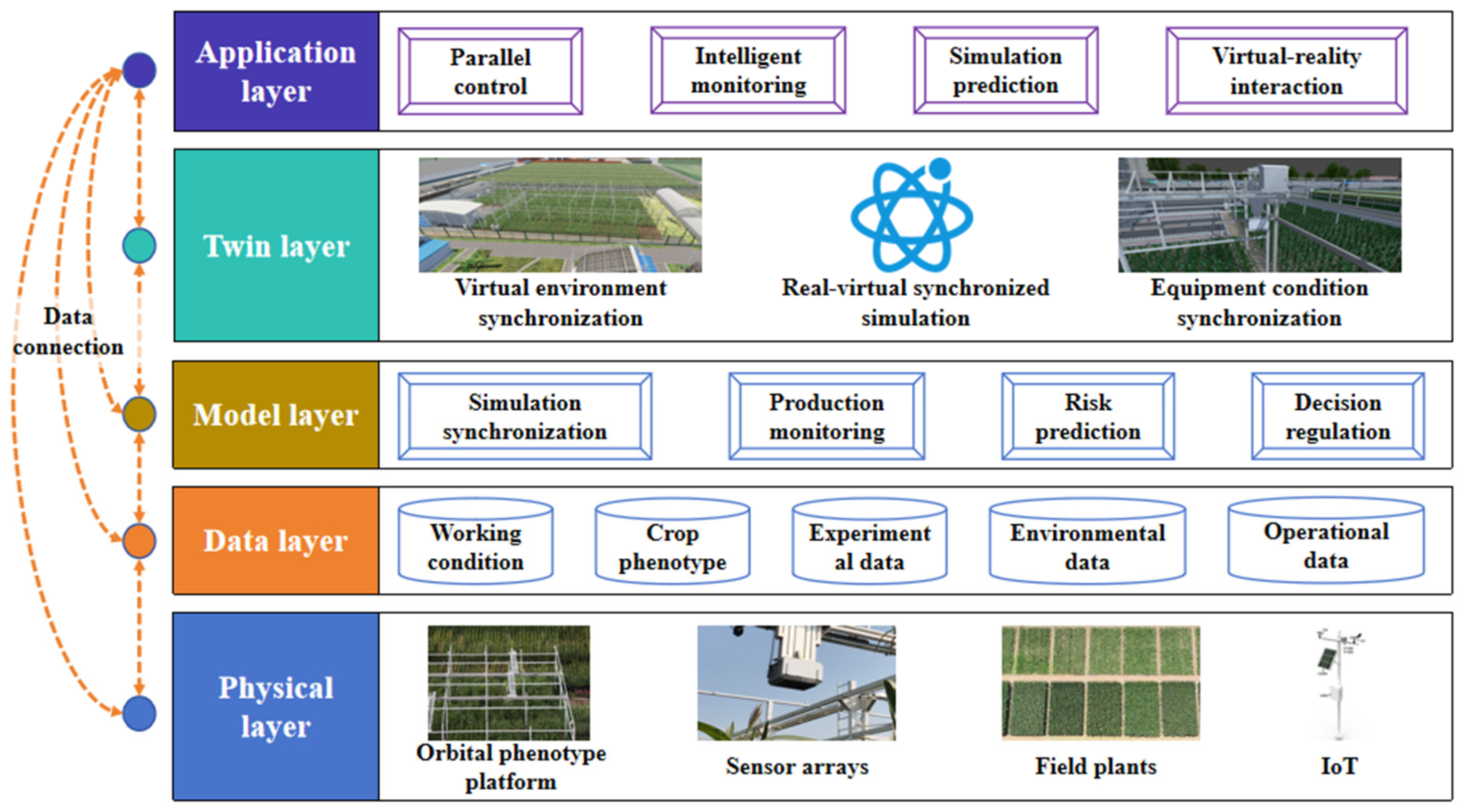
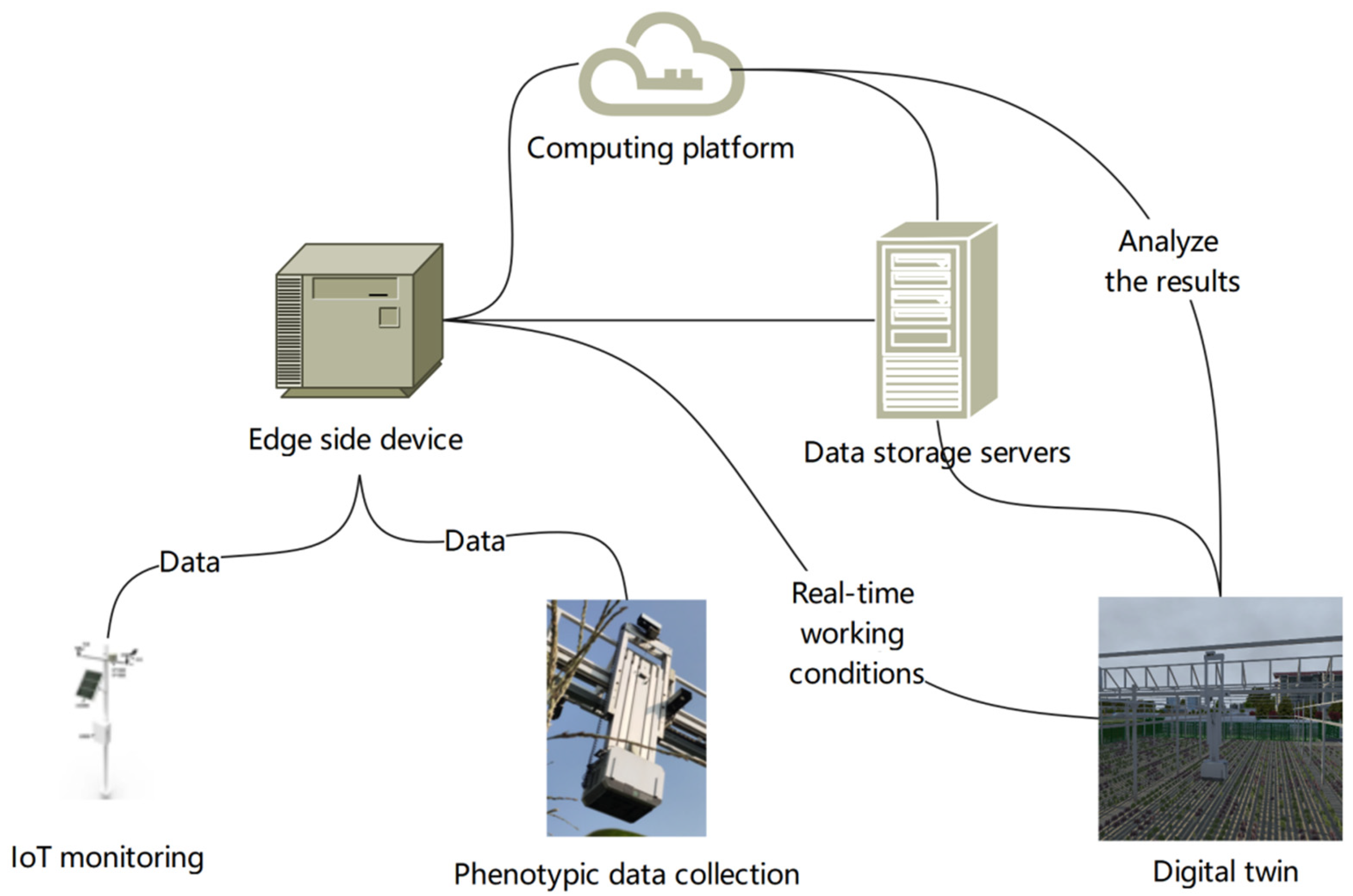
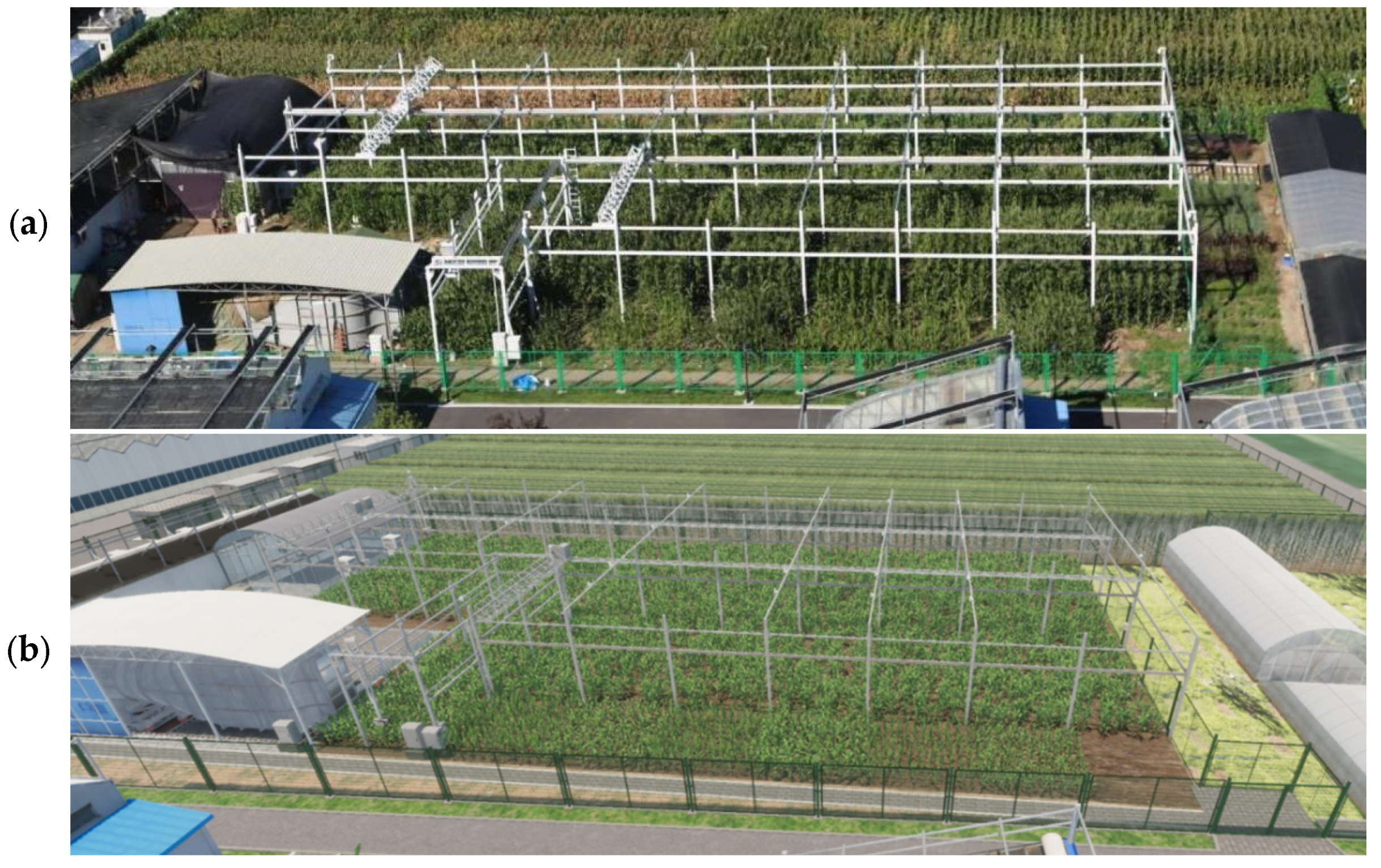

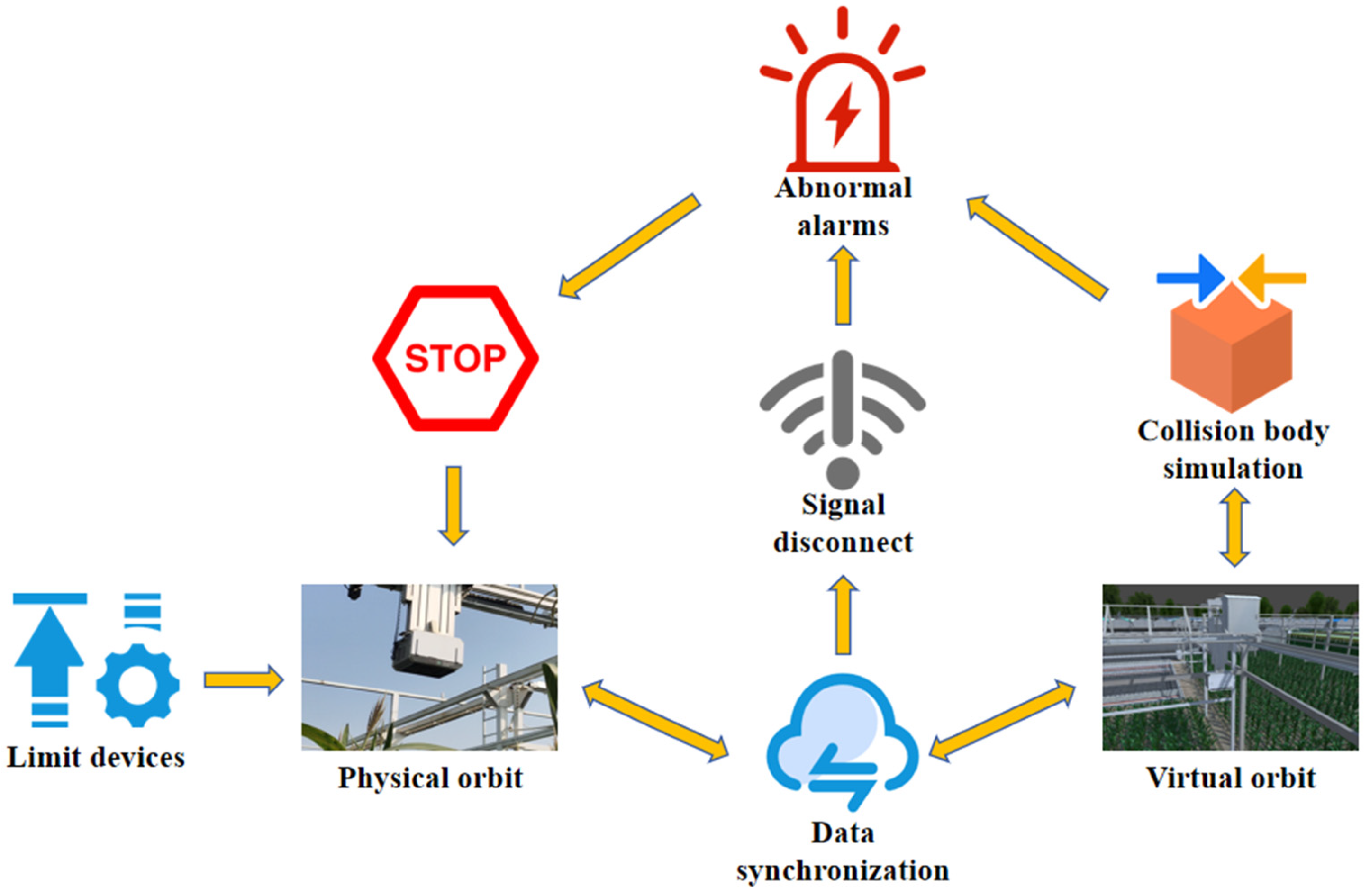
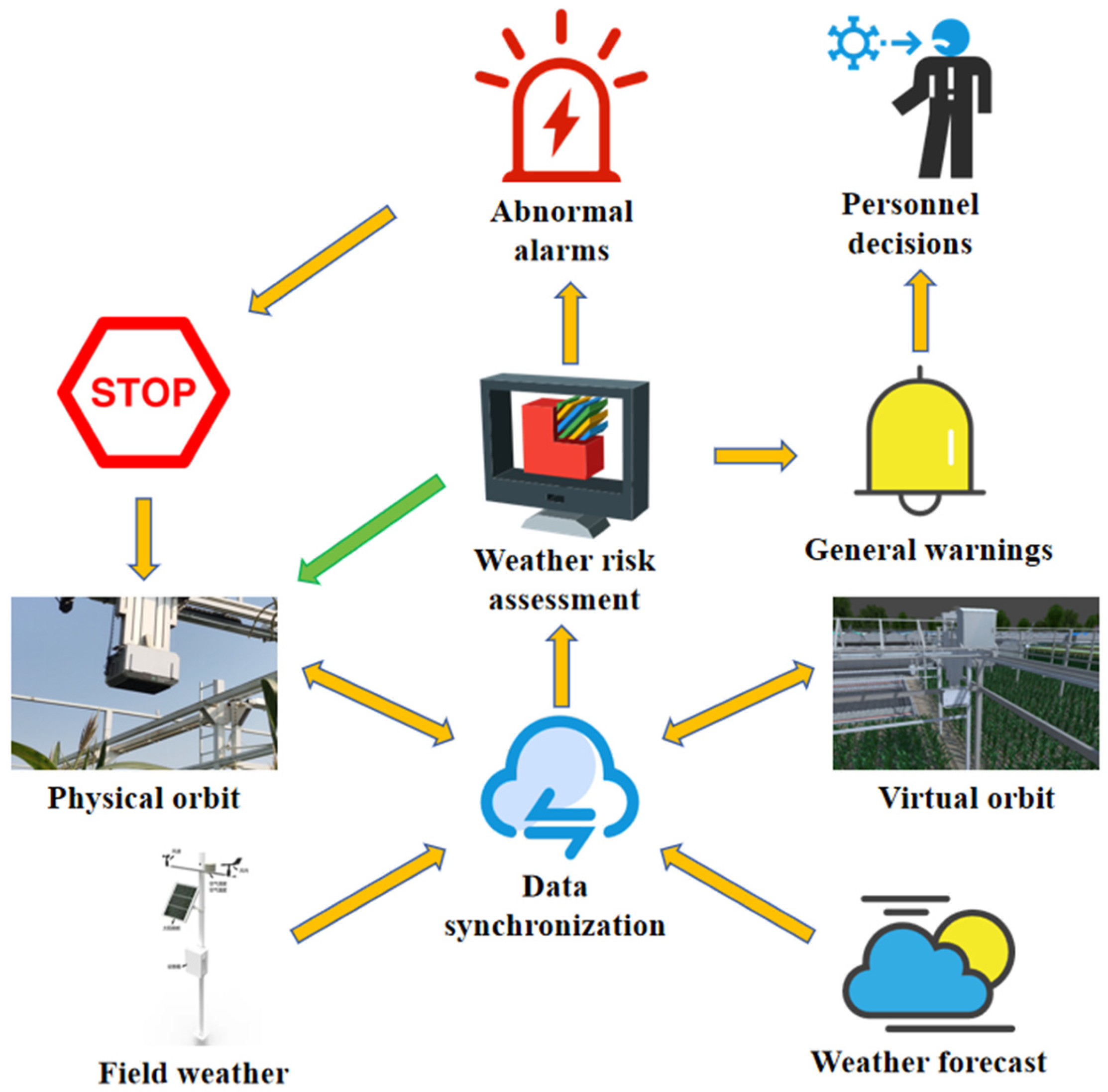

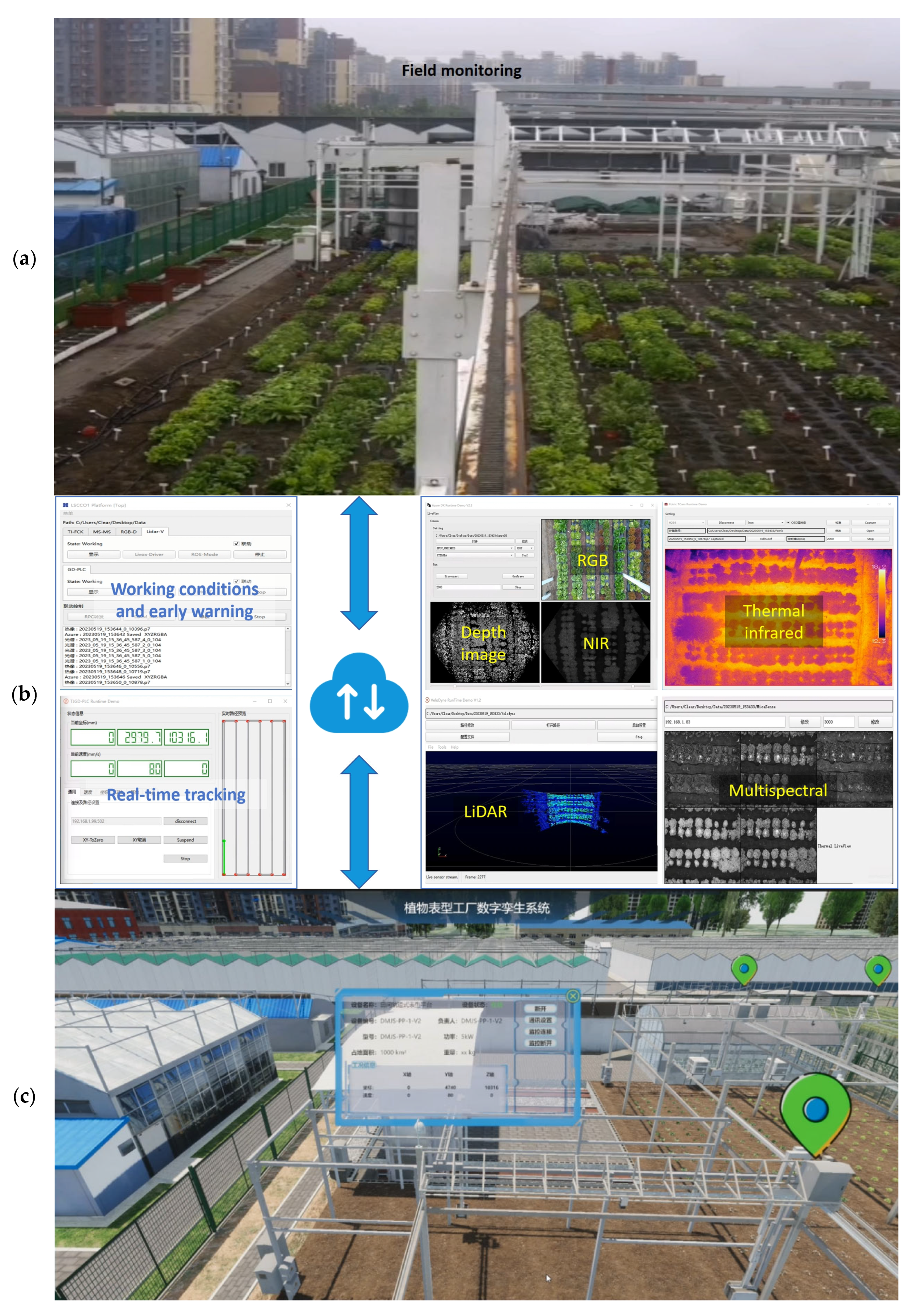
| U11 | U12 | U13 | U21 | U22 | |
|---|---|---|---|---|---|
| Wind speed, U11 | 1 | 3 | 5 | 3 | 7 |
| Rainfall, U12 | 1/3 | 1 | 2 | 1 | 3 |
| Irradiance, U13 | 1/5 | 1/2 | 1 | 1 | 2 |
| Wind power, U21 | 1/3 | 1 | 1 | 1 | 3 |
| Weather, U22 | 1/7 | 1/3 | 1/2 | 1/3 | 1 |
| Objective | Criteria | Weights | Indicator | Local Weight | Global Weight | Sorting |
|---|---|---|---|---|---|---|
| Weather risk assessment O | U1 | 0.7 | U11 | 0.5 | 0.35 | 1 |
| U12 | 0.3 | 0.21 | 2 | |||
| U13 | 0.2 | 0.14 | 4 | |||
| U2 | 0.3 | U21 | 0.7 | 0.21 | 3 | |
| U22 | 0.3 | 0.09 | 5 |
| Risk Score | 90 | 70 | 50 | 30 |
|---|---|---|---|---|
| U11 (m/s) | ≤2 | 2.1–3.0 | 3.1–4.0 | >4 |
| U12 (mm/h) | ≤1.5 | 1.6–6.9 | 7.0–14.9 | >14.9 |
| U21 | ≤2 | 3 | 4 | ≥5 |
| U21 (μmol/m2/s) | ≥1000 | 600–1000 | 200–600 | ≤200 |
| U22 | ∈Sunny | ∈Overcast, cloudy | ∈Light rain, showers | ∈Moderate rain and above |
| Risk Judgment | Judgment Scoring Thresholds | Response Strategy |
|---|---|---|
| Security | Perform acquisition tasks as planned | |
| General warning | Alert the operator to the details of the warning | |
| Risk warning | Cancelation or suspension of tasks; optimized scheduling to high-scoring timeslots |
| Risk level | Dates | Number of Determinations | Particulars | Strategic Decision |
|---|---|---|---|---|
| High-risk warnings | 21 June | 1 | Weather: Light rain, 12:50 p.m., combination of rainfall and low PAR levels | During non-operational hours, prompt the operator |
| 23 June | 35 | Level 3 winds; the risk warning is concentrated after noon; light intensity is higher at noon, and afternoon warning moment wind speeds are >4 m/s; evening wind speeds are back down 3 m/s; light insufficient | Cancelation of the 13:30 slot; cancelation of the 16:30 slot | |
| 24 June | 1 | Overlapping effects of episodic gusts and overcast events; wind speed, 4.0 m/s; PAR = 196 μmol/m2/s | Pause acquisition for 5 min and continue | |
| 29 June | 8 | Average wind speed, 3.5 m/s; heavy rain; risk warning time clustered after 18:00 | during non-operational hours; prompt the operator | |
| 12 July | 1 | Weather: Heavy to moderate rain; warning triggered at 13:40 due to increased rainfall | Pause acquisition for 5 min and continue |
Disclaimer/Publisher’s Note: The statements, opinions and data contained in all publications are solely those of the individual author(s) and contributor(s) and not of MDPI and/or the editor(s). MDPI and/or the editor(s) disclaim responsibility for any injury to people or property resulting from any ideas, methods, instructions or products referred to in the content. |
© 2025 by the authors. Licensee MDPI, Basel, Switzerland. This article is an open access article distributed under the terms and conditions of the Creative Commons Attribution (CC BY) license (https://creativecommons.org/licenses/by/4.0/).
Share and Cite
Liu, H.; Wen, W.; Gou, W.; Lu, X.; Ma, H.; Zhu, L.; Zhang, M.; Wu, S.; Guo, X. Research on Intelligent Control Technology for a Rail-Based High-Throughput Crop Phenotypic Platform Based on Digital Twins. Agriculture 2025, 15, 1217. https://doi.org/10.3390/agriculture15111217
Liu H, Wen W, Gou W, Lu X, Ma H, Zhu L, Zhang M, Wu S, Guo X. Research on Intelligent Control Technology for a Rail-Based High-Throughput Crop Phenotypic Platform Based on Digital Twins. Agriculture. 2025; 15(11):1217. https://doi.org/10.3390/agriculture15111217
Chicago/Turabian StyleLiu, Haishen, Weiliang Wen, Wenbo Gou, Xianju Lu, Hanyu Ma, Lin Zhu, Minggang Zhang, Sheng Wu, and Xinyu Guo. 2025. "Research on Intelligent Control Technology for a Rail-Based High-Throughput Crop Phenotypic Platform Based on Digital Twins" Agriculture 15, no. 11: 1217. https://doi.org/10.3390/agriculture15111217
APA StyleLiu, H., Wen, W., Gou, W., Lu, X., Ma, H., Zhu, L., Zhang, M., Wu, S., & Guo, X. (2025). Research on Intelligent Control Technology for a Rail-Based High-Throughput Crop Phenotypic Platform Based on Digital Twins. Agriculture, 15(11), 1217. https://doi.org/10.3390/agriculture15111217








